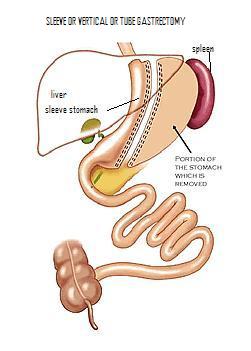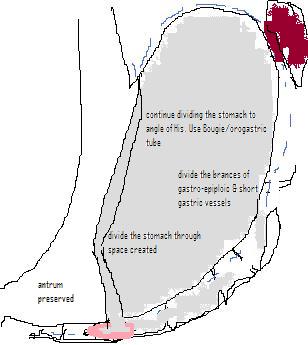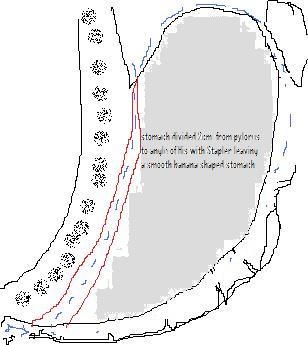Sleeve Gastrectomy / Gastric Sleeve
To watch a video profile on Gastric Sleeve click here.
LINKS TO YOUTUBE FOR THE SURGERIES
- Gastric sleeve / sleeve gastrectomy: https://www.youtube.com/watch?v=9DaioAs-HHg
- Hiatus Hernia repair + Ligamentum Teres Cardiopexy for Acid Reflux GORD post Sleeve Gastrectomy: https://www.youtube.com/watch?v=h3NOI5zZBSw&t=2s
It involves removing ¾ of Stomach along the greater curve of the stomach leaving the stomach in the form of a narrow tube.
Sleeve Gastrectomy involves removing ¾ to 4/5 of stomach vertically leaving a narrow tube of stomach with pylorus sphincter intact. This effectively restricts the stomach capacity without affecting its function. Stomach may hold about 60 – 100cc at any time. Also it will reduce the appetite as Ghrelin (appetite causing hormone) levels come down.
This operation was originally developed as first stage of the 2 stage Duodenal switch in higher BMI patients (over 60) and is modified to lower BMI patients (around 40) instead of gastric band because of the good results.
How is Gastric Sleeve Performed?
It is done in 2 ways:–
1. Antrum sparing SG ‘pyramidal’ type: this is done as 2 stage procedure. This may reduce the excess weight by about 30 – 50%. The stomach will eventually (after 12 – 18 months or so) expand and may not restrict the food that much. Therefore 2nd stage of surgery – Duodenal Switch is performed at this time when the weight has stabilised or started to rise.
2. Antrum stunting Sleeve Gastrectomy or Complete Sleeve Gastrectomy ‘Banana’ type: The stomach is made into a narrow tube from the cardia to pylorus 1/2-1cm from the angle of His to about 2cm from the pylorus i.e the whole length of stomach not sparing the antrum. One can lose about 70-80% of one’s excess weight within a year and a half and the results are comparable to gastric bypass at 2 and 4 years. But the ‘tube’ like stomach can stretch over 6 years though not to the original size and food intake is increased. Of course one should have changed one’s lifestyle especially healthy eating and exercises.
What are the advantages of Gastric Sleeve?
1. The weight loss achieved is good. It is achieved by reducing the amount of food one can eat and reducing or abolishing the appetite for about a year. Taste perception may change. There is no foreign body and therefore it is of low maintenance unlike the gastric band.
2. There is no rearrangement of the bowel and no malabsorption as in Gastric Bypass.
3. The procedure could be repeated, if the stomach increases in size too much ( which happens in antrum sparing Sleeve gastrectomy or if too much fundus is left behind) or Malabsorption procedure in the form of Duodenal Switch or gastric bypass could be added later to create required weight loss.
What are the main risks with Sleeve Gastrectomy?
1. There is a risk of staple line disruption of 1:100. (The leak is noticed because of the increased pain within the first 24 hours, raised CRP and increasing pulse rate; and corrected by re-laparoscopy). The risk is more if you use CPAP /BiPAP for OSA.
2. Bleeding can occur from the long staple line of the stomach. You may require further surgery (laparoscopy), CT guided aspiration of the blood collected or just blood transfusion alone to correct the problem.
3. GORD – gastro-oesophageal reflux or heartburn can be a problem especially in the first few months of surgery. That’s why you should have RYGB rather than Sleeve, if you have already severe GORD. In selected cases fundoplication (anti-reflux procedure) could be added to Sleeve to prevent GORD; it is still in the preliminary stage and research setting
When can I start work or exercises?
All the operations are performed laparoscopically and therefore patients do recover quickly and most of them can go gym after 1 week and for a swim after 2 weeks. You should be able to go to work by 10 days to 2 weeks though some have gone back to work by 5th day.
What diet I have to take after surgery.
You will be on a liquid/liquidised (blenderised) diet for 4weeks followed by soft diet and solid diet over the next 2 weeks or so. You will be able to eat egg size amount of food and then gradually able to eat more and will be able to eat about a small plate sized portion by 6 months. You have to eat slowly, chew well and stop eating the moment you feel full. You should not eat and drink at the same time; You can either drink before food or drink about half an hour after food. You should always focus on vegetables and protein in the diet.
What medications I have to take?
1. Vitamin supplements – chewable or liquid ones in the first month and then any capsule or tablet form after that. Vitamin D3 (Colecalciferol) 1000units regularly and probably Injection B12 1mg once in 3 months especially in the first 1 month.
2. Soluble Lansoprazole (Fastab) 30mg twice a day in the first two weeks and then any PPIs (Lansoprazole, Omeprazole etc) for another 3-6 months. You should continue them if you are on non-steroid anti-inflammatory pain killers like Ibuprofen, Diclofenac.
3. Lactulose or other aperients in the first few weeks after surgery for constipation. Psyllium husk 2capsules or 2tsf of powder could be taken after 1st week to create bulk in stool and help motility of the gut.
When can I become pregnant?
You have to wait until your weight is stable for a while which is usually about 1 ½ years after surgery.
Does Gastric Sleeve have any failures?
Hardly any. Of course all the weight loss surgeries can be only successful if one changes lifestyle – eating healthily and taking up regular exercises. If you take calorie dense foods like chocolate, cakes, crisps and biscuits, you are bound to put on weight.
How to prevent hair loss?
Taking good amount of protein ( require protein supplement in the first 6 months) and taking multivitamins containing Selenium, zinc, magnesium and iron will hlep mitigate the hair loss. of course the hair loss stalls and the hair start growing once you start eating normally..


